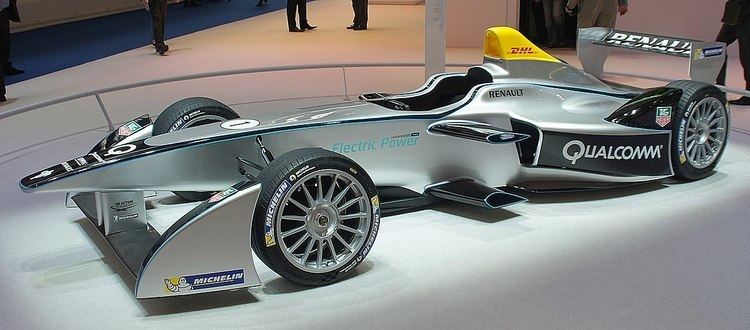Designer(s) Frédéric Vasseur | Suspension (rear) Spring | |
 | ||
Category FIA Formula E Championship Constructor DallaraSpark Racing Technology Suspension (front) Double steel wishbones, pushrod operated with twin dampers and torsion bars | ||
The Spark-Renault SRT_01E is an electric formula race car designed for the inaugural season of Formula E, in 2014–15. The car is the result of a 10-month collaboration between Spark Racing Technology, McLaren Electronic Systems, Williams Advanced Engineering, Dallara and Renault.
Contents
Development
Development of the car started in September 2012. Lucas di Grassi was appointed as official test driver, demonstrating the prototype, the Formulec EF01 (built in 2010). The Formulec EF01 featured a chassis constructed by Mercedes GP and motors built by Siemens. The car was used for the official promotion video and for demonstrations in host cities.
On 1 November 2012, McLaren Electronic Systems was announced to provide the electric motor, transmission and electronics for Formula E. The Formula E organisation ordered 42 cars from Spark Racing Technology. For this order Spark partnered with well renowned formula car manufacturer Dallara.
Michelin was announced as exclusive tyre supplier on 28 March 2013. On 15 May 2013 Renault was announced as technical partner of Spark Racing Technology. Renault's experience in the Renault Z.E. (Zero Emission) and Formula One programmes will be used to put to Formula E's advantage. On the same day, Formula E unveiled the design of the Spark-Renault SRT_01E.
The battery design was in the hands of Williams Advanced Engineering, part of the Williams Group to which the Formula One team belongs.
At the Frankfurt Motor Show, on 10 September 2013, the Spark-Renault SRT 01E was revealed by FIA president Jean Todt and Formula E Holdings CEO Alejandro Agag.
On 3 July 2014, the first official trial of the cars took place in Donington Park, England. The trial ended around 21 August with each team running all four of their cars completing a combined total of 1222 laps. The fastest time was 1:29.920, recorded by the Abt team – a McLaren MP4-12C recorded a lap time of 1:29.679 during the 2012 British GT season.
RESS
The Spark-Renault SRT_01E will feature a Rechargeable Energy Storage System (RESS). According to Appendix J article 251 3.1.7 of the ISC, the RESS is the complete energy storage device, comprising an energy storage medium (e.g. flywheel, capacitor or battery). The design of the RESS is free but must be homologated by the FIA. Part of the RESS is the traction batteries and the Battery Management System, these are supplied by Williams Advanced Engineering.
Electric motor
The electric motor is built by McLaren Electronic Technologies. The motor weighs 26 kg and produces a maximum of 270 bhp with 140Nm of instant torque. The motor was originally developed for the McLaren P1 road car.
Charging
According to the regulations, the Formula E cars can be charged during practice, qualifying, the race and some other specified moments during a raceweekend. Drayson Racing and its technical partner QualcommHALO are developing a way to wirelessly charge the car. The wireless electric vehicle charging (WEVC) system uses a pad under a parking space to charge the car. The system is tested on the electric Drayson B12/69EV, a modified version of the Lola B08/60.
Tyres
The car will be shod with 18 inch tyres. The FIA Formula E championship uses a tyre which is suitable for wet and dry conditions. The exclusive tyre supplier Michelin will only make one compound available, so there will be no hard or soft compounds like in Formula 1. The tyre is expected to last the whole race weekend.
Design
Technology
Dimensions
Power
Maximum power will be available during practice and qualifying sessions. During races, power-saving mode will apply with the 'Push-to-Pass' system temporarily allowing maximum power for a limited time. The amount of energy that can be delivered to the Motor Generator Unit (MGU) by the Rechargeable Energy Storage System (RESS) is limited to 30 kWh. This will be monitored by the FIA.
Performance
Final performance figures are still to be verified.
Motors
Traction battery
Rechargeable Energy Storage System
Chassis
The Dallara built car features:
Gearbox
Brakes
The body of the calipers must be made from aluminium alloy
Wheels and tyres
Electronics
Suspension
Steering system
Safety
Camera equipment
In video games
The series commissioned established sim racing developer MAK-Corp to create the SRT_01E for their Hyperstimulator Simulators for use at promotional events for the series. MAK-Corp's car is not available for public use. The car also features in Turn 10 Studios' game Forza Motorsport 5.
